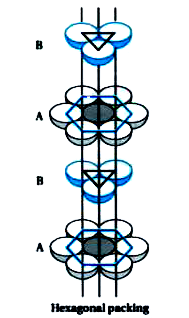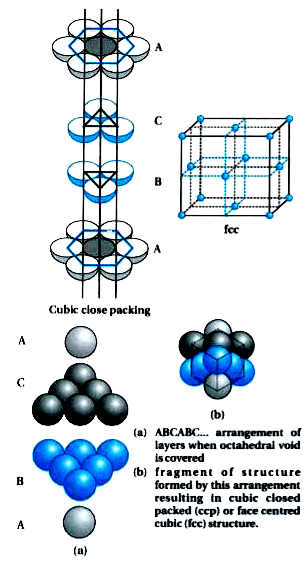Explain formation of face centred cubic unit cell and hexagonal close packing in three dimensions.
In hexagonal close packing layer in two dimensions, there are two sets of triangular voids. The three dimensional arrangement is obtained by stacking the two dimensional hexagonal layers one above the other.

Over the first layer (say "A") of two dimensional hexagonal arrangement, if the second layer (say "B") is placed, the one set of triangular void of layer "A" is covered by the spheres of layer "B".

Over the second layer "B", there are again two sets of triangular voids. If the third layer is placed over the triangular voids of second layer such that the spheres of third layer an first layer in exact alignment, the hexagonal close packing in three dimensional is obtained.

The third layer and first layer are exactly same and hence it is called "A" type. Thus the arrangement obtained is ABABAB.... Pattern.
Ex. : Zn and Mg shows this type of arrangement.
 .
.
If the third layer of the spheres are placed over the triangular voids of the second layer that are formed just above the unoccupied voids of the first layer, the face cubic centred unit cell is formed.
The third layer is different from layers A and B. Hence, if the third layer is called "C", the arrangement obtained is ABCABCABC... ie., fourth layer of sphere and first layer of spheres are exactly same.

Ex. : Metals such as Cu, Ag, etc. crystallizes in FCC structure.
In both type of close packing structures, the packing efficiency is 74% and co-ordination number is 12.
Topper's Solved these Questions
- THE SOLID STATEBOOK - KUMAR PRAKASHANCHAPTER - THE SOLID STATEEXERCISE - SECTION - A (EXAMPLES)
5 Videos
- THE SOLID STATEBOOK - KUMAR PRAKASHANCHAPTER - THE SOLID STATEEXERCISE - SECTION - B (INTEXT QUESTIONS AND ANSWERS)
23 Videos
- THE SOLID STATEBOOK - KUMAR PRAKASHANCHAPTER - THE SOLID STATEEXERCISE - SECTION - E (MULTIPLE CHOICE QUESTIONS)(MCQs ASKED IN BOARD EXAMS)
35 Videos
- THE P-BLOCK ELEMENTS BOOK - KUMAR PRAKASHANCHAPTER - THE P-BLOCK ELEMENTS EXERCISE - SECTION-E (MULTIPLE CHOICE QUESTIONS (MCQS)) (MCQS ASKED IN BOARD EXAM)
77 Videos
Similar Questions
In hexagonal close packing of spherer in three dimensions.
View SolutionMathc the type of packing given in Column I with the itmes given in Column II.
Column -I
(i) square close packing in two dimensions
(ii) Hexagonal close packing in two dimensions
(iii) Hexagonal close packing in three dimensions
(iv) Cubic close packing in three dimensions
Column -II (a) Triagnular voids
(b) Pattern of spheres is reapted in every fourth layer
(c) Coordination number -4
(d) Pattern of sphere is reapeated i alternate layers.
View Solution
Knowledge Check
In face-centred cubic unit cell :
Aface diagonal of the cube is a√2 or 4r
(a=edge length, r=radius of constituent units)Beffective number of atoms in the unit cell is 4C8 tetrahedral voids per unit cellDrank of the unit cell is 3In hexagonal close packing of spherer in three dimensions.
AIn one unit cell there are 12 octahedral voids and all are completely inside the unit cell.BIn one unit cell there are six octahedral voids and all are competely inside the unit cell.CIn one unit cell there are six octahedral voids and of which three are completely inside the unit cell and other three are from contributions of octahedral voids which are partially inside the unit cellDin one unit cell there are 12 tetrahedral voids, all are completely inside the unit cell.In hexagonal close packing of spheres in three-dimensions
Ain one unit cell there are 12 octahedral voids and all are completely inside the unit cellBin one unit cell there are six octahedral voids and all are completely inside the unit cellCin one unit cell there are six octahedral voids out of which three are completely inside the unit cell and other three are from contributions of octahedral voids which are partially inside the unit cellDin one unit cell there are 12 tetrahedral voids, all are completely inside the unit cell.
Packing refers to the arrangement of constituent units in such a way that the forces of attraction among the constituent particles is the maximum and the contituents occupy the maximum available space. In two dimensions, there are hexagonal close packing and cubic close packing. In three dimentions, there are hexagonal, cubic as well as body centred close packings.
The empty space left in ccp packing is:
View SolutionIn a face-centred cubic cell, an atom at the face contributes to the unit cell
View SolutionPacking refers to the arrangement of constituent units in such a way that the forces of attraction among the constituent particles is the maximum and the contituents occupy the maximum available space. In two dimensions, there are hexagonal close packing and cubic close packing. In three dimentions, there are hexagonal, cubic as well as body centred close packings.
The empty space left in hcp packing is:
View SolutionPacking refers to the arrangement of constituent units in such a way that the forces of attraction among the constituent particles is the maximum and the contituents occupy the maximum available space. In two dimensions, there are hexagonal close packing and cubic close packing. In three dimentions, there are hexagonal, cubic as well as body centred close packings.
The space occupied by spheres in bcc arrangement is:
View SolutionPacking refers to the arrangement of constituent units in such a way that the forces of attraction among the constituent particles is the maximum and the contituents occupy the maximum available space. In two dimensions, there are hexagonal close packing and cubic close packing. In three dimentions, there are hexagonal, cubic as well as body centred close packings.
The pattern of successive layers in ccp arrangement is:
View Solution
